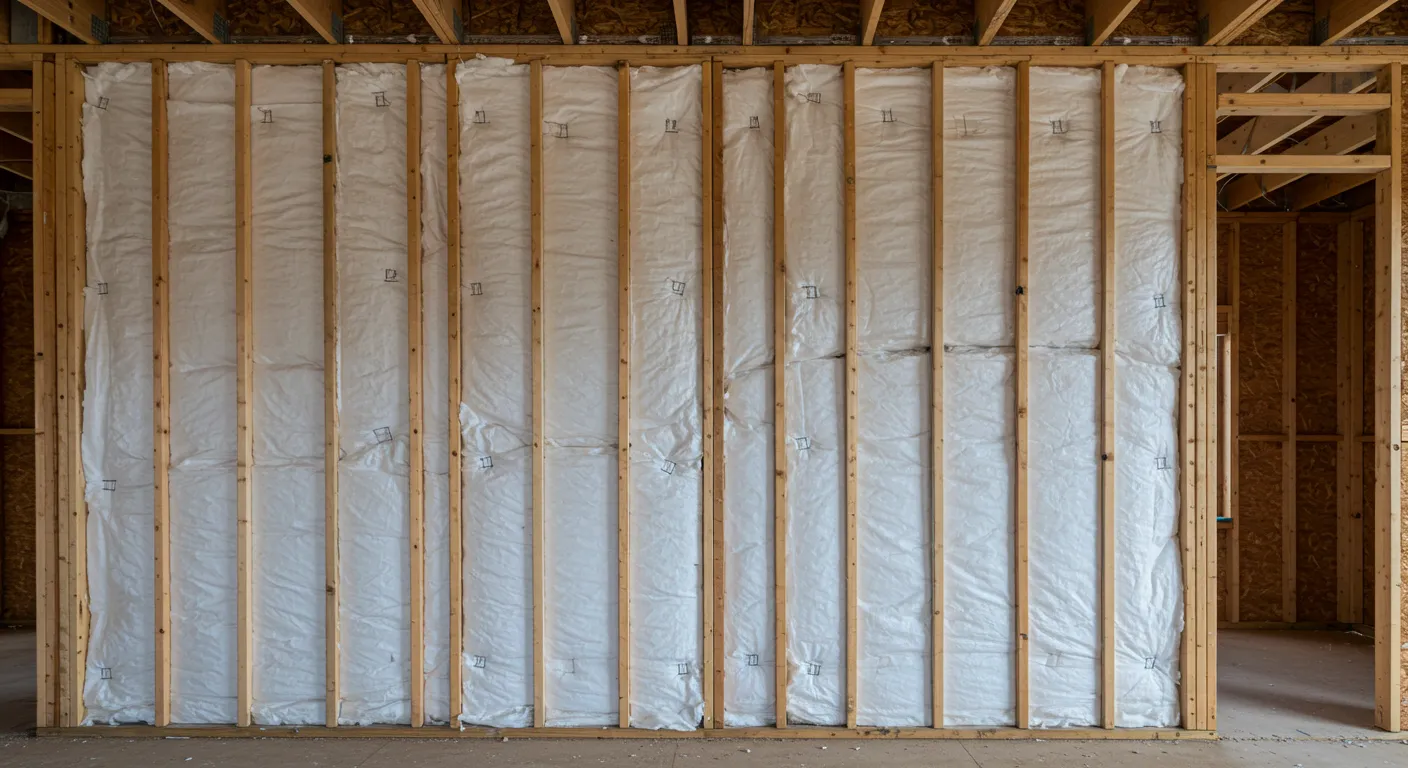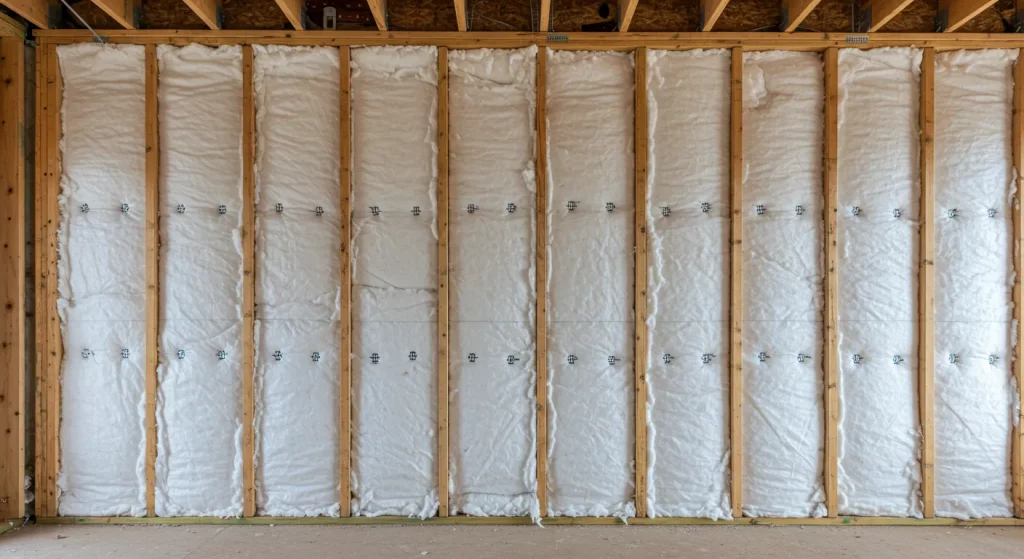
Blown-in blanket insulation provides superior moisture control in Leander homes by creating a continuous thermal barrier that reduces temperature differentials and minimizes condensation formation. This insulation method fills gaps and voids that traditional batts cannot reach, preventing warm, humid air from contacting cool surfaces where moisture problems typically develop.
The key to effective moisture management lies in eliminating thermal bridging and air infiltration points. Blown-in blanket systems conform to irregular surfaces and structural elements, creating an uninterrupted insulation layer that maintains consistent temperatures throughout wall cavities and attic spaces. This temperature stability prevents the conditions that lead to condensation, mold growth, and structural moisture damage.
Leander’s humid subtropical climate presents unique moisture challenges for residential buildings. Summer temperatures regularly exceed 95°F with humidity levels reaching 70-80%, while winter conditions can drop to freezing with significant temperature swings. These conditions create ideal scenarios for condensation when warm, moisture-laden air encounters cooler building surfaces.
According to the National Weather Service, Leander receives approximately 33 inches of annual rainfall, with peak humidity occurring during morning hours throughout most of the year. This consistent moisture presence requires insulation systems that can effectively manage vapor transmission while maintaining thermal performance.
Blown-in blanket insulation addresses these conditions through its unique installation method. The material is pneumatically installed behind a mesh or fabric restraint, allowing complete filling of wall cavities at specified densities. This process eliminates settling concerns while ensuring consistent coverage around electrical outlets, plumbing penetrations, and structural members where traditional insulation often leaves gaps.
Bonus Tip: Install vapor barriers on the warm side of insulation in climate zones like Leander’s Zone 2A to prevent moisture migration from interior conditioned spaces into wall cavities during cooling seasons.
| Insulation Type | Air Sealing Capability | Moisture Resistance | Installation Consistency | Thermal Bridge Prevention |
|---|---|---|---|---|
| Blown-In Blanket | Excellent | High | Superior | Excellent |
| Fiberglass Batts | Poor | Moderate | Variable | Fair |
| Spray Foam | Excellent | Superior | Excellent | Excellent |
| Cellulose Blown-In | Good | Good | Good | Good |
| Property | Blown-In Blanket Performance | Industry Standard |
|---|---|---|
| Density (lbs/ft³) | 1.5-2.2 | 0.5-1.8 |
| Air Permeability (cfm/ft²) | <0.02 | <0.05 |
| Moisture Absorption (%) | <5 | <15 |
| Vapor Permeability (perms) | 15-25 | 10-30 |
| Settling Rate (%) | <1 | <5 |
The controlled density installation of blown-in blanket insulation creates consistent thermal performance that prevents temperature variations within building assemblies. Research from Oak Ridge National Laboratory demonstrates that uniform insulation density reduces convective air movement within wall cavities by up to 85% compared to traditional batt installation methods.

Effective moisture management requires addressing both thermal and air barrier functions simultaneously. Blown-in blanket insulation excels in this application because the installation process naturally seals small gaps and penetrations that allow moisture-laden air infiltration.
The pneumatic installation method forces insulation material into crevices around electrical boxes, plumbing runs, and structural intersections where moisture problems commonly originate. This comprehensive coverage prevents the stack effect and wind-driven air movement that can transport humidity into building assemblies.
Bonus Tip: Combine blown-in blanket installation with targeted air sealing at major penetrations using appropriate sealants before insulation installation for maximum moisture control effectiveness.
Blown-in blanket insulation maintains its moisture control properties over extended periods due to its stable installation characteristics. Unlike loose-fill materials that can settle and create thermal voids, the contained installation method preserves consistent density and coverage throughout the building’s lifespan.
Field studies conducted by the Insulation Contractors Association of America show that properly installed blown-in blanket systems retain 95% of their initial thermal performance after 20 years of service. This stability directly translates to consistent moisture control performance, as thermal bridging and air infiltration rates remain constant over time.
The material’s inherent moisture resistance also contributes to long-term effectiveness. Quality blown-in blanket products incorporate treatments that prevent moisture absorption while allowing vapor transmission, maintaining the delicate balance required for effective moisture management in mixed-humid climates.
Blown-In Blanket System Installation Complete cavity filling with precise density control ensures optimal thermal and moisture performance for residential and commercial applications.
Attic Retrofits with Blown-In Technology Upgrade existing attic insulation using blown-in methods to eliminate thermal bridging and improve moisture control in existing structures.
Thermal Barrier System Integration Comprehensive building envelope solutions combining blown-in insulation with air sealing for maximum moisture management effectiveness.
Espuma en aerosol para nueva construcción Advanced spray foam applications for superior moisture control in new construction projects requiring enhanced performance specifications.
Evaluate existing moisture conditions before installing any insulation system. Identify and address active leaks, drainage issues, or ventilation problems that could compromise insulation performance. Blown-in blanket systems work best when integrated into properly designed building envelopes with adequate vapor management strategies.
Consider the specific requirements of your home’s construction type and age. Older homes may require additional air sealing measures before blown-in installation, while newer construction might benefit from integrated moisture management approaches that address both thermal and vapor control simultaneously.
Climate zone requirements significantly impact insulation strategies. Leander’s Zone 2A classification requires specific approaches to vapor barrier placement and ventilation design that must be coordinated with insulation installation for optimal moisture control results.
Bonus Tip: Schedule installation during moderate weather conditions when humidity levels are lower to ensure optimal material handling and installation quality.
Understanding installation logistics helps homeowners prepare for blown-in blanket projects effectively. The process requires temporary removal of interior wall coverings in retrofit applications, making timing and contractor coordination essential factors in project planning.
Determine whether existing insulation needs removal before new installation. In many cases, blown-in blanket systems can be installed over existing materials, but moisture-damaged or settled insulation should be removed to ensure optimal performance of the new system.
Verify that electrical and plumbing systems meet current codes before insulation installation. Blown-in methods can reveal wiring or plumbing issues that require attention, and addressing these concerns beforehand prevents project delays and additional costs.
Target densities between 1.5-2.2 pounds per cubic foot provide optimal moisture control while maintaining thermal performance. Higher densities improve air sealing but may reduce thermal resistance, requiring careful balance based on specific application requirements.
Both systems excel at moisture control, but a blown-in blanket offers better vapor permeability while spray foam provides superior air sealing. Blown-in systems cost less initially while spray foam delivers higher long-term performance in extreme moisture conditions.
Yes, blown-in blanket installation in existing walls requires creating access holes that are sealed after completion. This retrofit approach effectively improves moisture control in older homes without major renovation requirements.
Properly installed blown-in blanket systems require minimal maintenance. Annual inspection of vapor barriers and ventilation systems ensures continued moisture control effectiveness. Address any settling or gaps immediately to maintain optimal performance.
Moisture control improvements become apparent within days of installation as temperature differentials decrease and condensation formation reduces. Full effectiveness develops over several weeks as the building envelope reaches thermal equilibrium with the new insulation system.
Blown-in blanket insulation delivers proven moisture control benefits for Leander homeowners dealing with humidity challenges. The system’s ability to create continuous thermal barriers while allowing controlled vapor transmission makes it particularly effective in Central Texas climate conditions. Success depends on proper installation density, integration with existing building systems, and coordination with appropriate vapor management strategies.
Evaluate your specific moisture concerns, existing building conditions, and long-term performance requirements when selecting insulation solutions. Professional assessment ensures that blown-in blanket installation addresses your home’s unique moisture control needs while delivering lasting thermal performance benefits.
H & R Spray Foam Insulation provides comprehensive blown-in blanket installation services throughout the Leander area, combining technical expertise with quality materials for effective moisture control solutions. Our experienced team evaluates existing conditions, recommends appropriate insulation strategies, and ensures proper installation for optimal long-term performance.
Contact H & R Spray Foam Insulation at (979) 325-2419 or [email protected] to schedule a consultation and discover how blown-in blanket insulation can solve your home’s moisture control challenges. Professional assessment and installation ensure maximum effectiveness for your specific building conditions and climate requirements.
Blown-in blanket insulation significantly reduces mold risk by eliminating temperature differentials that create condensation conditions where mold typically develops. However, existing moisture sources like plumbing leaks or inadequate ventilation must be addressed before installation to ensure complete mold prevention.
Blown-in blanket systems can improve moisture control in homes with minor humidity issues, but active water intrusion or severe condensation problems require correction before insulation installation. The system works best when integrated into comprehensive moisture management that addresses ventilation, air sealing, and vapor control simultaneously.
Quality blown-in blanket installations maintain consistent moisture control performance for 20-25 years when properly installed at correct densities. The contained installation method prevents settling that compromises thermal barriers while ensuring continued effectiveness throughout the building’s service life.
Yes, blown-in blanket insulation performs well in high-humidity areas like bathrooms and kitchens when combined with appropriate vapor barriers and ventilation systems. The installation must account for plumbing penetrations and electrical fixtures while maintaining consistent coverage around these moisture-prone areas.
Blown-in blanket materials resist moisture absorption and typically dry completely when exposed to normal air circulation. Minor wetting during installation rarely affects long-term performance, but significant water exposure may require partial replacement of affected areas to maintain optimal moisture control capabilities.